I recently discovered this website and am trying to find more information on the sword, when it was made, and who made it. I value any insight that members may offer and thank you all in advance. I have tried to compare the kanji to other characters, but I have no idea what they are. What I have been told: In 2003, I became interested in learning more about the blade and its value and wanted to know whether it was a machine-made sword or a Shinken. I reached out to a Sensei at a local Kendo dojo in the U.S. and brought him the sword. (NOTE: I do not know how experienced he was, but he was local and it was convenient to take it to him. I do not expect anybody to give deference to his opinion, I am only stating what I have been told). He said that the hamon was a "rare" type. I don't know what he was referring to, but I have read that the hamon style was sort of like a signature or brand. He took off the tsuka and tried to read the kanji, but he said that they were "too old" for him to read. I believe he was referring to the style of kanji, but have no idea. He told me that the tang appeared to have been cut-down, possibly to fit within the shorter tsuka used by the Japanese military in WWII. He asked whether anything had been done to the nakago, because it appeared that the rust may have been "cleaned off" at some point. I have no idea whether that happened or not, since my grandfather passed away long ago. It is difficult to tell whether there is new rust that has formed on top of old rust, and whether the old rust had been removed or partially removed. The ruler in the photos is a 15-inch ruler, so the blade appears to be around 27-28 inches in length. I am currently away from my katana, so I can't measure it precisely. I look forward to your opinions. |
|||
 |
Nihonto ClubJapanese Sword Information Exchange |
User login |
|
|
Disclaimer: Nihontō Club owners and independent contributors will not be held responsible for any loss, damage or inconvenience caused as a result of any inaccuracy or error within this website. Except where otherwise noted, this page is licensed under a Creative Commons License.
|
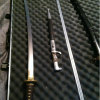
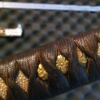
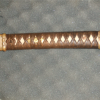
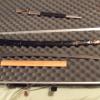
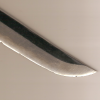

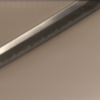
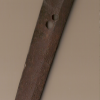
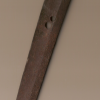

something-Toshi
Hi, It's hard to see details of the signature in the pictures.
There are a total of 6 kanji. The last 3 appear to be "Toshi saku kore".
The "Toshi" is the 2nd half of the smith's name, so the kanji before that is very important, but I can't see enough details of it...
"saku kore" means "made this".
The first two kanji are likely a province name.
As you probably know, the blade appears to be much older than WWII...
It's true that the blade's tang has been shortened - indicated by the end of the tang being a squared off.
I don't see anything "rare" about the hamon.
Regarding the two holes in the tang: the slightly larger one is the original, the other was probably added in WWII times to fit it to the WWII-style handle.
The handle, scabbard, and such look like standard WWII stuff.
I should add that rust on the tang looks fairly normal to me, and I don't see obvious signs of anything being cleaned/modified. The important thing about the rust is the color - how much 'red' vs how much 'black'. It's very hard to tell from pictures.
Pete
Next steps?
Pete,
Thank you very much for your insight.
After reading your post, I did some more research to try to see if I could recognize any more of the kanji. I see how that kanji looks like "toshi," so I did a search for last names that end with it. I couldn't find anything that resembled the kanji above it.
I would have figured that the kanji above it would have been easier to identify, due to the distinct line of hashmarks running up the left side of it. After searching about 2500 different figures, I couldn't find anything close...
It will be a few months before I will be back with my sword, so I won't be able to take any more photos until that time. I have a better camera now.
Do you have any ideas as to what the kanji at the top above the hole may be? Would that typically be a date?
Thanks again.
province
Hi,
As I said, the first two kanji are likely a province name.
You can find a list online, and maybe match it up visually without being able to "read" the kanji.
Pete